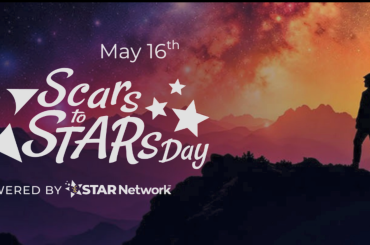In our Yoga Recovery meetings, we’re doing a series on the Chakras and the twelve steps. I’m sharing this weekly series here on the In The Rooms blog as well. Last week, we covered the Root Chakra. This week, we’ll move into the Sacral Chakra. Stay tuned as we cover all seven Chakras!
The Sacral Chakra
This is a very cursory review of the chakra and its elements, powers, and influences. There are emotional and physical impacts of the chakras that I won’t be delving into here.
The colors of the chakras move in rainbow order. So as we progress from the root chakra to the sacral chakra, we move from red to orange. The color orange, the stone carnelian, and the element water represent the sacral chakra. If underactive, surround yourself with orange. On the other hand, if this chakra is overactive, wear blue. The Sanskrit name is for the sacral chakra is Svadhisthana, meaning to be seated in one’s own (identity, being, place) or dwelling in one’s self. What a beautiful image!
Sacral Chakra governs sexuality, but also intimacy, community outside family, creativity, relationships and agency. The gift is feelings and sensations—think movement, fluid, passion.
Addictive Behaviors and Societal and Generational Challenges
Individuals with an overactive sacral chakra may develop addiction to alcohol, drugs, or other unhealthy substances, or engage in high-risk behaviors. Additionally, they may partake in excessive eating or undereating, and develop an unhealthy focus on one’s body image.
There are also societal and generational challenges to having a well-balanced sacral chakra. Society promotes sexuality. It is magnified and glorified. And yet, sex can be seen as unidimensional and become a source of feeling rejected or objectified. As a result, this can cause deep seated internal conflict, no matter what your gender identification, preference or where you fit along that spectrum. Society can restrict, confine and create caricatures of who we feel and who we love.
One of the processes in reintegrating ourselves is to answer some questions such as: What does society expect, desire, suggest, promote or affirm of me (as a woman or a man, a member of the race of strongest influence or not, age, and so on)? Some of us have been brought up on one coast and moved to another. That can bring on culture shock. Imagine having a natal family from one country and culture and being raised in another? This can cause feelings of dis-unity and dis-integration. This results in an unbalanced sacral chakra.
Another challenge of active addiction was the divorce and abandonment of my inner self. Cutting off my somatic perceptions of physical sensations, dulling my senses, and being drawn to disordered intimate relationships with others were all part of my addiction behaviors.
A Balanced Sacral Chakra
A balanced sacral chakra gives you the power to move, to connect, to create, to let go, and to experience things just as they are. You have the ability to feel and to want. Imbalance can occur in two ways: from an overactive chakra, but also from a stuck/underactive chakra. When my sacral chakra is stuck, I feel mired in guilt, regret, disunity, and grief. And the opposite is true. When I am feeling those things, I can inhibit the free circulation of sacral chakra energy.
So what does this have to do with the steps?
The Twelve Steps and the Sacral Chakra
Step 4 in particular (in all the programs I have worked ) has helped me re-balance this chakra. Unearthing sources of misunderstanding, uncovering incorrect views of reality, reinstalling CHOICE have all helped me recover a good relationship with this chakra and maintaining its balance.
Other steps I employ are Step 10, 6 and 7. Step Ten give me a moment to moment, daily or periodic check in, a pause to reflect on how things are going and if I am acting in accordance to my true values and ethics.
When I am in danger of having an emotional relapse into non-sober behaviors, I can look to my 6th and 7th steps. Remembering that I don’t do recovery alone (I have peeps, a sponsor and my H.P.) I can consider my defenses and shortcomings and offer them up. Feelings are not binary—good or bad, right or wrong, shameful or exalted). Feelings are on a continuum. I ask my HP to dial me in onto the proper wavelength of my emotions. The sacral chakra can give me guidance regarding boundaries and manners of expression. The right of the sacral chakra is to feel. The obstacle can be guilt or any emotion experienced to a negative degree.
One of the ways to check into your chakra is to ask yourself some questions.
- Are the yin and yang, masculine and feminine, aspects of myself acknowledged?
- Are they balanced?
- Do I practice holding healthy boundaries?
- Am I aware I have personal agency, choice especially when it comes to my body?
- Am I open for changes in my life?
- Can I be of service from my excess rather than my reserves?
- Can I give freely without thoughts of others reciprocating or expressing gratitude?
- Do I feel I have to sacrifice something so that others can be happy?
- Do I care for my own good as well as the good of others?
- When I feel life is difficult, am I aware that I have the resources to deal with it?
In addition to working the steps of recovery, you may want to add additional self care tools such as these:
- Yoga poses with slow transitions and long holds.
- Drink lots of water.
- If the chakra is overactive, wear blue.
- If your chakra is underactive, wear orange.
- Draw, sing, write, sew, throw pots: be creative.
- Use affirmations in your self talk: I flow with creativity and freedom; I experience my feelings without judgement; I have a right to my limits and my boundaries; I practice healthy relationships in all areas of my life.
- Become aware of all your senses and “feed” them with love.
Compassion, indeed passion, for yourself and your investigation of the sacral chakra as well as working the steps may help you find greater balance in all your relationships.







